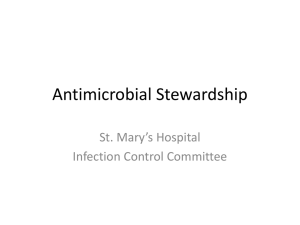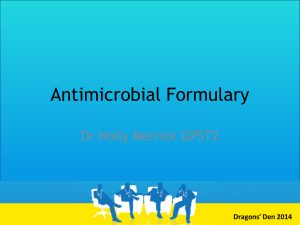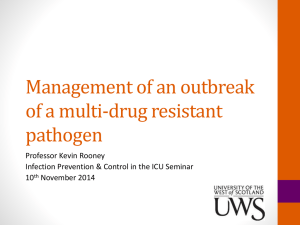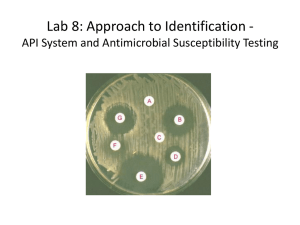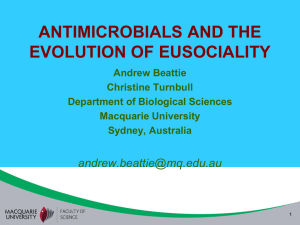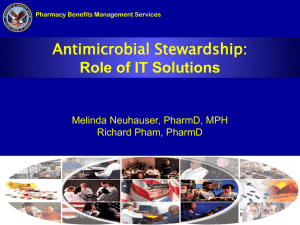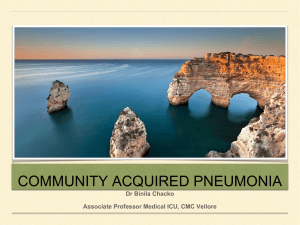Massimo Antonelli
advertisement
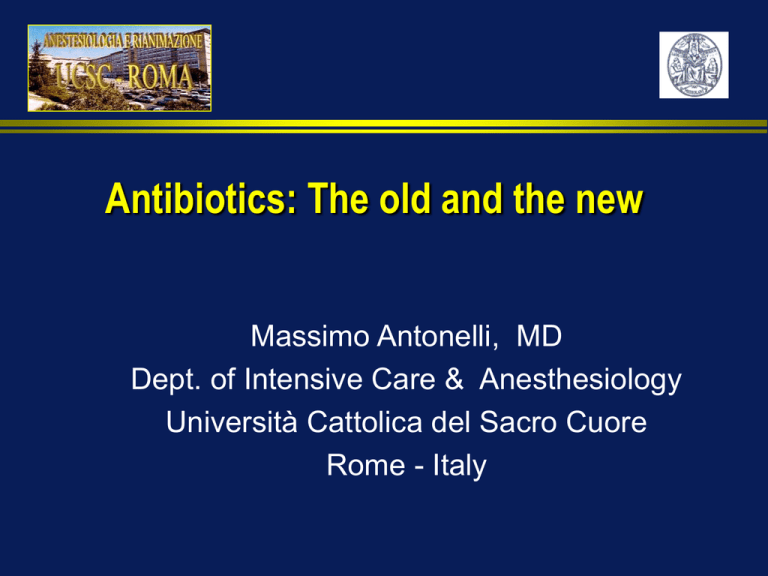
Antibiotics: The old and the new Massimo Antonelli, MD Dept. of Intensive Care & Anesthesiology Università Cattolica del Sacro Cuore Rome - Italy Major sites of infection in medical ICU PNE UTI 5% 5% 6% 30% 4% 3% 1% BSI OTHR SST EENT CVS GI LRI 16% 30% n= 13,592 Richards MJ, et al. Infect Control Hosp Epidemiol 2000; 21: 510-515 Facts • Multi-resistant germs are common • Antimicrobial resistance increases over time • Inadequate therapy is associated with Mortality • Can we adopt specific strategies to decrease resistance ? Most Frequently Reported Pathogens from ICU Patients with Nosocomial Pneumonia 1. 2. 3. 4. 5. Pseudomonas aeruginosa Staphylococcus aureus Enterobacter spp. Klebsiella pneumoniae Acinetobacter spp. Richards MJ et al. Crit Care Med 1999; 887-892. S. aureus —The Most Frequent Isolate in EPIC Study 35 30,1 30 28,7 25 19,1 20 17,1 13 15 10 5 0 S. aureus P. aeruginosa Vincent JL, et al. JAMA 1995;274:639-644. Vincent JL. Int Care Med 2000;26:S3-S8. CoNS Fungi E. coli MRSA Pneumonia: Infection-Related Mortality 70 Mortality (%) 60 56,3 54,5 50 38 40 30 20 10 0 Gonzalez, 1999 Rello, 1994 Iwahara, 1994 Multiresistant bacteria are a problem in VAP Organism % of all isolates P. aeruginosa 31.7 MRSA 11.8 A. baumannii 11.8 H. influenzae 8.4 S. pneumoniae 7.7 MSSA 3.1 (n = 321 isolates from 290 episodes) Rello J. Am J Respir Crit Care Med 1999; 160:608-613. Acinetobacter baumannii Resistance in 118 ICUs of 5 European Countries Antibiotic France Portugal Spain Ceftazidime 70% 81% 76% Pip/taz 44% 75% 58% Amikacin 36% 10% 51% Ciprofloxacin 78% 75% 81% Imipenem 9% 5% 16% Pip/taz=piperacillin/tazobactam Hanberger H et al. JAMA 1999;281:67-71. Variables indipendently associated with VAP caused by “Potentially Resistant” bacteria * Variable Odds Ratio 95% CI p Value Duration of MV before VAP episode 7 d (Y/N) 6.01 1.6-23.1 .009 Prior antibiotic use (Y/N) 13.46 3.3-55.0 .0003 Broad-spectrum antibiotics (Y/N) 4.12 1.2-14.2 .025 * Discriminant value (AUC) = 0.89 Trouillet JL., et al. AM J RESPIR CRIT CARE MED 1998; 157: 531-539 Facts • Multi-resistant germs are common • Antimicrobial resistance increases over time • Inadequate therapy is associated with Mortality • We may adopt specific strategies to decrease resistance: antibiotic rotation ? Antimicrobial Resistance in Nosocomial Infections Gram-Negative Pathogens P aeruginosa Resistant to Imipenem 15 10 5 Klebsiella pneumoniae Not Susceptible to Third-Generation Cephalosporin 15 10 5 Year 00 20 99 19 98 19 97 96 19 95 19 94 19 19 93 92 19 91 19 19 19 19 Source: NNIS Data. Clin Chest Med. 20:303-315. 90 0 89 Percent Resistance 01 00 20 99 20 98 19 97 19 96 19 95 19 94 19 93 Year Year ICU Patients Non-ICU Patients 19 92 19 90 91 19 19 19 89 0 19 Percent Resistance 20 01 00 25 20 99 20 98 19 97 19 96 19 95 19 94 19 93 19 92 19 91 19 19 19 19 90 35 30 25 20 15 10 5 0 89 Percent Resistance P aeruginosa Resistant to Quinolones Antimicrobial Resistance of Nosocomial Infections Gram-Positive Pathogens Methicillin-Resistant CoagulaseNegative Staphylococci Percent Resistance 01 00 20 99 20 98 19 97 19 19 96 95 94 19 92 93 19 19 19 19 Year 2001 2000 1999 1998 1997 1996 1995 Year 35 30 25 20 15 10 5 0 Source: NNIS data. Clin Chest Med. 20:303-315. 1994 2001 Vancomycin-Resistant Enterococci 89 ICU Patients Non-ICU Patients Percent Resistance Year 1999 1993 1997 19 1995 91 1993 19 1991 90 1989 1992 0 1991 10 1989 40 30 20 100 80 60 40 20 0 1990 60 50 19 Percent Resistance Methicillin-Resistant S aureus Facts • Multi-resistant germs are common • Antimicrobial resistance increases over time • Inadequate therapy is associated with Mortality • We may adopt specific strategies to decrease resistance: antibiotic rotation ? Mortality Associated With Initial Inadequate Therapy In Critically Ill Patients With Serious Infections in the ICU Initial appropriate therapy Alvarez-Lerma,1996 Rello, 1997 Initial inadequate therapy Kollef, 1999 Kollef, 1998 Ibrahim, 2000 Luna, 1997 Mortality* 0% 20% 40% *Mortality refers to crude or infection-related mortality Alvarez-Lerma F et al. Intensive Care Med 1996;22:387-394. Ibrahim EH et al. Chest 2000;118L146-155. Kollef MH et al. Chest 1999; 115:462-474 Kollef MH et al. Chest 1998;113:412-420. Luna CM et al. Chest 1997;111:676-685. Rello J et al. Am J Resp Crit Care Med 1997;156:196-200. 60% 80% 100 % Reducing Inadequate Therapy Antibiotic Management Through Practice Guidelines 18 Number of Days 16 14 Computer-Generated Regimen Physician-Generated Regimen * † * 12 10 * 8 6 4 2 0 Duration of Length of ICU Admission Total Length of Antibiotic ICU Stay to Discharge Stay Therapy *P<0.001. †P<0.003. Evans, et al. N Engl J Med. 1998;338:232. Risk Factors for Resistance in VAP • Use of antibiotics within 15 days1 • Duration of hospitalization2 • Duration of mechanical ventilation > 7 days1 1Trouillet J-L et al. Am J Respir Crit Care Med 1998;157:531-539. 2Lautenbach E et al. Clin Infect Dis 2001;32:1162-1171. Facts • Multi-resistant germs are common • Antimicrobial resistance increases over time • Inadequate therapy is associated with Mortality • We may adopt specific strategies to decrease resistance: antibiotic rotation ? Campaign to Prevent Antimicrobial Resistance in Healthcare Settings Antimicrobial Resistance: Key Prevention Strategies Antimicrobial-Resistant Susceptible Pathogen Pathogen Prevent Transmission Pathogen Prevent Infection Infection Antimicrobi al Resistance Effective Diagnosis & Treatment Optimize Use Antimicrobial Use Campaign to Prevent Antimicrobial Resistance in Healthcare Settings Key Prevention Strategies Prevent infection Diagnose and treat infection effectively Use antimicrobials wisely Prevent transmission Clinicians hold the solution! 12 Steps to Prevent Antimicrobial Resistance: Hospitalized Adults 12 Steps to Prevent Antimicrobial Resistance: Hospitalized Adults Prevent Infection 1. Vaccinate 2. Get the catheters out Diagnose and Treat Infection Effectively 3. Target the pathogen 4. Access the experts Use Antimicrobials Wisely 5. 6. 7. 8. 9. 10. Practice antimicrobial control Use local data Treat infection, not contamination Treat infection, not colonization Know when to say “no” to vanco Stop treatment when infection is cured or unlikely Prevent Transmission 11. Isolate the pathogen 12. Break the chain of contagion 12 Steps to Prevent Antimicrobial Resistance: Hospitalized Adults Use Antimicrobials Wisely Step 6: Use local data Fact: The prevalence of resistance can vary by local, patient population, hospital unit, and length of stay. Actions: know your local antibiogram know your patient population Link to: NCCLS Proposed Guidance for Antibiogram Development Antonelli, 1994, Chest; 105:224-28 Risk factors for Early Onset Pneumonia 14,6 Age <= 40 Age 41-65 Age > 65 30 41,7 * 19 Males Females 29,2 25 Multiple trauma Head trauma 13,6 30,6 Pulmonary contusion No pulmonary contusion 14,7 8,7 AIS 1^ AIS 2 AIS 3 26,9 46,7 * MV > 24 h MV <= 24 h or none 0 8,2 33,3 10 20 30 * 40 Incidence % * p-value < 0.05, chi-square test or Fisher's exact test ^ 1: thorax < 4, abdomen any score; 2: thorax > 4, abdomen <= 9; 3: thorax > 4, abdomen > 9 50 Variations in the etiology of VAP across ICUs No. isolates 44- 32- 13- 41 29- 35- 25- 20 14- 4- 7- 32 56 - 52- 10- 152 MV<7, AB- MV<7, AB+ MV>7,AB- MV>7,AB+ Pseudomonas 6 - 3 - 0 - 0 Acinetobacter 0- 12 - 15- 0 MRSA 0-0-0-0 65 -14 -12 -20 0 - 17 - 24 - 5 0-9- 0-5 43 - 25 - 28- 6 0 - 50 - 28 - 3 0-0-0-3 86 - 23- 30 - 22 0 - 33 -50 - 13 2 - 12 - 0 - 6 90 80 % Organisms 70 60 50 40 Barc. Mont. Sev Paris 30 20 10 0 Rello et al, AJRCCM 1999; 160: 608-13 12 Steps to Prevent Antimicrobial Resistance: Hospitalized Adults Use Antimicrobials Wisely Step 8: Treat infection, not colonization Fact: A major cause of antimicrobial overuse is “treatment” of colonization. 12 Steps to Prevent Antimicrobial Resistance: Hospitalized Adults Step 8: Treat infection, not colonization Invasive Bronchoscopic Diagnostic Tests Reduce Antimicrobial Use in Suspected VAP* Invasive Non-invasive Diagnosis Diagnosis Antimicrobial-free days (at day 28) 11.0 7.5 p < .001 Mortality 16.2% 25.8% p = .022 *413 patients; 31 intensive care units Fagon JY, et al: Ann Intern Med 2000;132:621-30 12 Steps to Prevent Antimicrobial Resistance: Hospitalized Adults Step 12: Contain your contagion Impact of Hand Hygiene on Hospital Infections Year Author Setting Impact on Infection Rates 1977 1982 1984 1990 1992 Casewell Maki Massanari Simmons Doebbeling adult ICU adult ICU adult ICU adult ICU adult ICU Klebsiella decreased decreased decreased no effect decreased with one versus another hand hygiene product 1994 Webster NICU 1995 Zafar 1999 Pittet MRSA eliminated nursery MRSA eliminated hospital MRSA decreased ICU = intensive care unit; NICU = neonatal ICU MRSA = methicillin-resistant Staphylococcus aureus Source: Pittet D: Emerg Infect Dis 2001;7:234-240 Link to: Improving hand hygiene ROTATION ? The evidence Kollef Ann Intern Med. 2001;134:298-314. Antibiotic rotation in the ICU : 10 Reviews, No RCT, 4 cohort studies Author Allegrazzi J Hosp Inf 2002 Raymond CCM 2002 Punziak Clin Inf Dis 2001 Gruson AJRCCM 2000 Level of Type Evidence of Infec. Pts. Period of Res. Rotation GNB Res GP S.aureus VRE Mortality II VAP 226/397 Surg 6 mo. ¯ ¯ na « II VAP 1445 1 yr ¯ ¯ na ¯ II Any 1273 6 mo. na na « na II VAP 392/3455 Survell. driven ¯ ¯ na « ANTIMICROBIAL RESISTANCES ANALYSIS Computer Assistance in Infection Control EXPERT SYSTEM FOR DECISION SUPPORT PHYSICIAN VALIDATED COMPUTER SUGGESTED SURELY NEGATIVE SURELY POSITIVE MISSING DATA DRUGS AMFOTERICINA AMIKACINA AMOXICILLINA AMOXICILLINA/AC. CLAVULANICO AMPICILLINA AMPICILLINA/SULBACTAM AZITROMICINA AZTREONAM BENZILPENICILLINA CEFALEXINA CEFALOTINA CEFAMANDOLO CEFAZOLINA CEFEPIMA CEFOTAXIMA CEFOTETAN CEFTAZIDIMA CEFTIZOXIMA CEFTRIAXONE CIPROFLOXACINA CLARITROMICINA CLINDAMICINA CLORAMFENICOLO DOXICICLINA ETAMBUTOLO FLUCONAZOLO GENTAMICINA IMIPENEM ED INIBITORI ENZIM. ISONIAZIDE LEVOFLOXACINA MEROPENEM METRONIDAZOLO NETILMICINA OFLOXACINA PEFLOXACINA PIPERACILLINA PIPERACILLINA/TAZOBACTAM PIRAZINAMIDE RIFAMPICINA SULFAMETOXAZ. E TRIMETOPRIM TEICOPLANINA 2000 2001 2002 39,35 gr 495 gr 270 gr 2511,94 gr 36,31 gr 1050 gr 336 gr 5529,6 gr 13,65 gr 450 gr 82 gr 2788 gr 1248 gr 633 gr 15 gr 40 gr 1778000 U.I. 64 gr 100 gr 370 gr 544 gr 578 gr 905 gr 186 gr 1710 gr 279 gr 2500 gr 320,5 gr 618 gr 90 gr 35 gr 3 gr 117 gr 99,6 gr 1685,4 gr 1085 gr 57,6 gr 112,5 gr 2464,5 gr 1193 gr 25,5 gr 17,4 gr 24,6 gr 6112 gr 12876,75 gr 100 gr 132,6 gr 195,84 gr 141 gr 140 gr 615 gr 15 gr 0 gr 168000 U.I. 0 gr 0 gr 288 gr 1041 gr 455 gr 414 gr 0 gr 1680 gr 608 gr 1970 gr 269,4 gr 469 gr 120 gr 10 gr 8 gr 137 gr 254,45 gr 2520,4 gr 76 gr 52,8 gr 295 gr 3985 gr 518,5 gr 13,5 gr 0 gr 16 gr 4950 gr 9641,25 gr 125 gr 87,4 gr 285,6 gr 187,7 gr 570 gr 495 gr 0 gr 0 gr 0 U.I 0 gr 0 gr 180 gr 373 gr 397 gr 200 gr 0 gr 280 gr 150 gr 1790 gr 107,7 gr 279,5 gr 72 gr 10 gr 4 gr 15 gr 91,8 gr 1091,2 gr 30 gr 24,1 98 gr 2753 gr 784,5 gr 6 gr 0,2 gr 14,4 gr 1360 gr 5805 gr 0 gr 74,4 gr 172,1 gr 76 gr RESISTANCES 2000 - 2001 AGENT PSEUDOMONAS AERUGINOSA AMPICILLINA CEFAZOLINA CEFTAZIDIME CIPROFLOXACINA GENTAMICINA 98,6% 89,5% 47% 55,3% 68,1% AGENT PSEUDOMONAS AERUGINOSA AGENT STAPHYLOCOCCUS AUREUS AMIKACINA AMOXICIL./ AC. CLAVUL. 3% 45,9% IMIPENEM 27,5% CLARITROMICINA OXACILLINA TRIMET/SULFAMET 62,4% 67,1% 14,2% AGENT STAPHYLOCOCCUS CAPITIS STAPHYLOCOCCUS EPIDERMIDIS STAPHYLOCOCCUS HAEMOLYTICUS STAPHYLOCOCCUS HOMINIS AGENT KLEBSIELLA PNEUMONIAE AGENT VANCOMICINA 0% TEICOPLANINA OXACILLINA VANCOMICINA 0% 50% 0% 4,3% 84,6% 0% 16,3% 90,1% 0% 2,2% 65,9% 0% AGENT AMPICILLINA PENICILLINA PENICILLINA G VANCOMICINA ENTEROCOCCUS FAECALIS D 1,9% 3,8% 6,7% 1,2% ENTEROCOCCUS FAECIUM D 83,3% 19,4% 72,2% 2% AGENT SERRATIA MARCESCENS PIPERAC./TAZOB. 31,6% GENTAMICINA 1,9% 0% AMPICILLINA CEFTAZIDIME AMIKACINA IMIPENEM 88,8% 41,6% 30,5% 0% AMPICILLINA AMIKACINA CEFTAZIDIME PIPERACILLINA IMIPENEM MEROPENEM 100% 18% 63,8% 91,5% 0% 0% AMPICILLINA CLARITROMICINA AMIKACINA CIPROFLOXACINA MEROPENE IMIPENEM M ACINETOBACTER BAUMANNII COMPLEX 96,6% 83,3% 30% 80% 3,3% 0% When to start Sandiumenge , Intensive Care Med 2003 on line 1. Antibiotic therapy should be started immediately Impact of microbiological investigation on guiding and de-escalating therapy 2. Antibiotic choice can be targeted, in some cases, on direct staining 3. The antibiotic regimen must be modified in the light of microbiological findings Dose and duration 4. Prolonging antibiotic treatment does not prevent recurrences. What microorganism should be covered 5. Patients with COPD or >1 week of ventilation should receive combination therapy, due to the risk of VAP due to Pseudomonas aeruginosa 6. MSSA should be strongly suspected if GCS<8. MRSA is not expected in the absence of prior antibiotic administration Sandiumenge , Intensive Care Med 2003 on line 7. Therapy against yeasts is not required, even in the presence of Candida spp colonization 8. Vancomycin administration for MRSA-related VAP (and for other Gram–positive pneumonias) is associated with a very poor outcome Choice of initial agent 9. Guidelines should be regularly updated and customized to local patterns 10. The specific choice of agent should be based on the regimen to which each patient has been exposed previously


